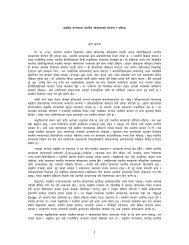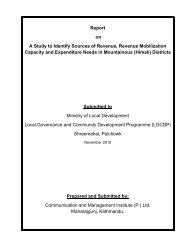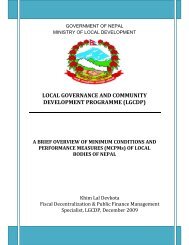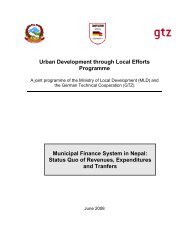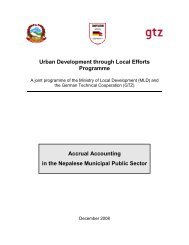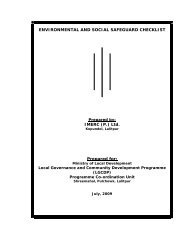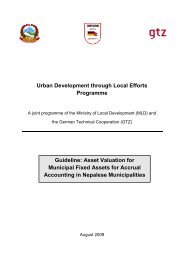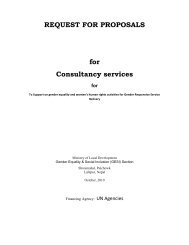GTZ Report on Proposal for Nepal Grant Formula - LGCDP
GTZ Report on Proposal for Nepal Grant Formula - LGCDP
GTZ Report on Proposal for Nepal Grant Formula - LGCDP
You also want an ePaper? Increase the reach of your titles
YUMPU automatically turns print PDFs into web optimized ePapers that Google loves.
<strong>Proposal</strong> <strong>for</strong> a municipal grant allocati<strong>on</strong> <strong>for</strong>mula 12<strong>Proposal</strong> <strong>for</strong> a future grant allocati<strong>on</strong> scheme <strong>for</strong> municipalities in a federal <strong>Nepal</strong>local governments. There<strong>for</strong>e, the gross fund deoiniti<strong>on</strong> <strong>for</strong> funds to be allocated to local governments – here municipalities – should be a fund that should be oilled by the federal government and should be open <strong>for</strong> regi<strong>on</strong>al governments <strong>for</strong> funding, too. There are two opti<strong>on</strong>s• First, all regi<strong>on</strong>s could use the total gross fund as an equalisati<strong>on</strong> element: All regi<strong>on</strong>s pay in accord-ing to a <strong>for</strong>mula to be agreed up<strong>on</strong>, and the funds are distributed across the nati<strong>on</strong>. The funding to a gross fund is an equalisati<strong>on</strong> element, as there might be regi<strong>on</strong>s that pay more in the fund than the municipalities are receiving in that regi<strong>on</strong>. However, this is depending <strong>on</strong> the revenue assignment to the regi<strong>on</strong>s. • Sec<strong>on</strong>d, if regi<strong>on</strong>s are not willing to use the gross fund as an equalisati<strong>on</strong> element, they could top up the federal grant anticipated <strong>for</strong> the municipalities within their regi<strong>on</strong>. What should be avoided and what should be limited by law is a multitude of different funding schemes, different grant allocati<strong>on</strong> schemes that would encourage imbalances in local government funding rather than to create a fair and equal funding opti<strong>on</strong>s <strong>for</strong> all urban areas in <strong>Nepal</strong>.3.2 Preference <strong>for</strong> unc<strong>on</strong>diti<strong>on</strong>al grants instead of c<strong>on</strong>diti<strong>on</strong>al grantsOne key questi<strong>on</strong> is designing local government oinance system is the need <strong>for</strong> federal or regi<strong>on</strong>al fund-ing of local governments in general, and thereafter the questi<strong>on</strong>, whether this federal or regi<strong>on</strong>al fund-ing should be unc<strong>on</strong>diti<strong>on</strong>al or c<strong>on</strong>diti<strong>on</strong>al.In principle, the local government oinance system in a federal state with str<strong>on</strong>g local governments in terms of legal aut<strong>on</strong>omy, oiscal aut<strong>on</strong>omy and relevance <strong>for</strong> the service delivery, should always seek to ensure sufoicient funding from own sources of revenue. As explained above, own sources of revenue are unlikely to be enough to fund <strong>for</strong> all functi<strong>on</strong>s assigned to local governments, there<strong>for</strong>e tax sharing agreements are essential in <strong>Nepal</strong>. However, even with the combinati<strong>on</strong> of own source revenues and shared taxes, oiscal imbalances might occur. Fiscal imbalances are typical <strong>for</strong> those state systems which grant local government oiscal aut<strong>on</strong>omy. The more income of local government is dependent <strong>on</strong> own source revenues, the more likely are imbalances in terms of per capita income, especially in a country with large differences between municipalities in terms of geographical setting and ec<strong>on</strong>omic activity such as <strong>Nepal</strong>.Unc<strong>on</strong>diti<strong>on</strong>al grants do have the functi<strong>on</strong> to guarantee the functi<strong>on</strong> of local government regardless where the local government is located and regardless the socio-‐ec<strong>on</strong>omic c<strong>on</strong>diti<strong>on</strong>. However, unc<strong>on</strong>di-ti<strong>on</strong>al grants may c<strong>on</strong>tain equalizati<strong>on</strong> elements to reduce vertical oiscal imbalances.C<strong>on</strong>diti<strong>on</strong>al grants should be small in number and small in amounts allocated. The main reas<strong>on</strong> is that c<strong>on</strong>diti<strong>on</strong>al grants are designed by deoiniti<strong>on</strong> to support specioic policy objectives of the Government. The Government has – through the instrument of c<strong>on</strong>diti<strong>on</strong>al grants – large opportunities to guide loc-al council decisi<strong>on</strong>s, as c<strong>on</strong>diti<strong>on</strong>al grants reduce the cost of service delivery or capital investments. There is no problem in having c<strong>on</strong>diti<strong>on</strong>al grants, however, there share of unc<strong>on</strong>diti<strong>on</strong>al grants should be much larger to enable local councils to fund local services according to the needs of the local people, while the share of c<strong>on</strong>diti<strong>on</strong>al grants should be much smaller to offer incentives <strong>for</strong> local councils to fund local services according to the political programme of the Government.Dr Alexander Wegener interpublic c<strong>on</strong>sultancywww.interpublic-‐berlin.de



